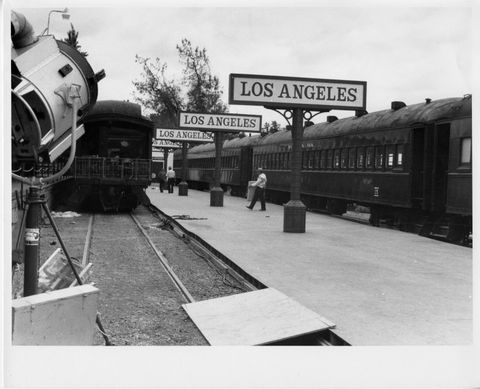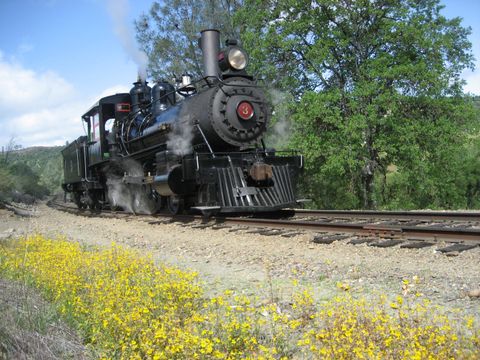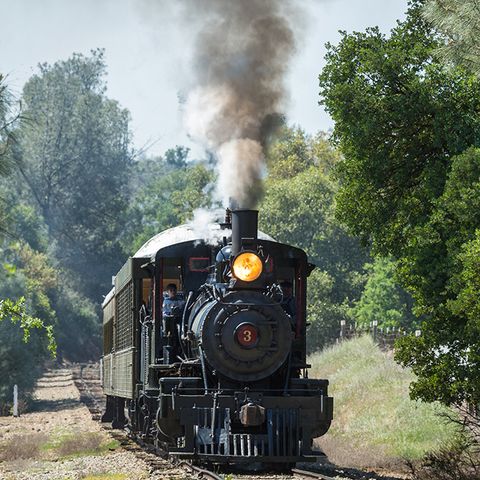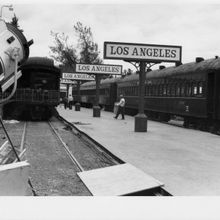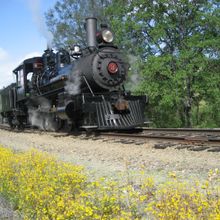JAMESTOWN, Calif. -- Railtown 1897 State Historic Park (SHP) is home to the famous Sierra No. 3™, also known as the Movie Star Locomotive. Sierra Railway steam locomotive No. 3 has been a movie star since the early 1900s when Hollywood producers first discovered Tuolumne County and its historic trains. Since then, Hollywood has been filming this photogenic steam locomotive along the Sierra Railroad's scenic route to satisfy America's love affair with Westerns.
Sierra No. 3™ is probably the most widely seen steam locomotive in the world. According to William L. Withhuhn, former curator of Transportation History at the Smithsonian Institution, “Sierra Railway No. 3 has appeared in more motion pictures, documentaries, and television productions than any other locomotive. It is undisputedly the image of the archetypal steam locomotive that propelled our country from the 19th century into the 20th.”
Clint Eastwood is one of this steam locomotive's co-stars and supporters: “The Sierra No. 3™ is like a treasured old friend. Early in my career, I rode Sierra No. 3™ on the television series Rawhide. Over twenty years later, I returned to use No. 3 for my own productions Pale Rider and Unforgiven. Even in the business of 'make believe,' you can't beat the real thing. Sierra No. 3™ resides at Railtown 1897 State Historic Park. It is housed in the original roundhouse which is still in use. Together these two assets provide a rare opportunity to experience history just as it was 109 years ago.”
Sierra No. 3™ has starred in more than 100 movies and television productions. Early in its Hollywood career, Sierra No. 3™ appeared in The Virginian with Gary Cooper in 1929, the very first sound movie filmed outside of a Hollywood sound stage. About a year later, the locomotive starred in The Texan, but as the Depression began, Sierra No. 3™ was sidelined while the Sierra Railway went through bankruptcy and reorganization. There simply wasn't enough traffic—and money—to keep the engine operable. In 1948, repairs to Sierra No. 3™ were completed and the locomotive returned to movie service. In the years following, it appeared in more than 30 movies, including High Noon, The Great Race, Bound for Glory, Back to the Future III and Unforgiven.
As television became a growing presence in America, Sierra No. 3™ entered living rooms everywhere in commercials and as a TV star (Lone Ranger, Tales of Wells Fargo, Petticoat Junction, Rawhide, Death Valley Days, Lassie, Gunsmoke, Bonanza, The Wild, Wild West, and Little House on the Prairie).
Since 1897, the Historic Jamestown Shops and Roundhouse (now Railtown 1897 State Historic Park) and Sierra No. 3™ have been central to community life in Tuolumne County. Railtown 1897 SHP today operates, preserves and interprets one of just two remaining, fully intact and still functioning steam-era shortline railroad roundhouse complexes in the United States. At one time, hundreds of similar facilities could be found throughout the country.
The Historic Jamestown Shops and Roundhouse complex was the operating center of the Sierra Railway. The Park's historic structures, vintage railroad equipment, and grounds provide an accurate portrayal of the steam railroading era in the region from 1897 through 1955. While railroads generally were the primary means of transportation in California from the 1870s to the 1950s, shortline railroads were an essential part of the railroad network—connecting with mainline or “trunk” railroad lines and transporting goods, supplies, and people to and from smaller, more distant communities. The Sierra Railway connected mining and timber industries in rural Tuolumne and Calaveras Counties with the rest of the state. The Sierra played an important role in the post-Gold Rush mining era and helped build the dams needed to create Don Pedro, Melones, and Hetch Hetchy reservoirs. These reservoirs in turn provided hydroelectric power and water for irrigation, and contributed to the development of San Francisco and central California.
Sierra No. 3™ was built in 1891 by Rogers Locomotive Works in Paterson, New Jersey. Rogers began during the early 1800s, as the industrial revolution took hold in North America, and got its start in the textile industry. The company at first turned out machine parts, and eventually transitioned to become a locomotive manufacturer. When the owners of Rogers sold to the American Locomotive Company in 1905, they had produced more than 6,100 locomotives, including the General (which participated in the “the great locomotive chase” during the Civil War's famed Andrews raid) and Union Pacific No. 119, which was present at the Golden Spike ceremony commemorating the completion of the Transcontinental Railroad in 1869, among others. Today, only a handful of Rogers-built locomotives remain in operation, including the Sierra No. 3™.
Sierra No. 3™ was originally purchased in 1891 for use on the Prescott & Arizona Central, a railroad owned by Thomas Bullock which soon failed. Bullock then went on to found the Sierra Railway. It is said that the locomotive was transported by rail to a port in Southern California, then transported by steamship up the coast to the San Francisco Bay and the Port of Stockton. It was then used in the building of the Sierra Railway from Oakdale, hauling rail, ties and work crews along the route as the railroad was built.
This famous locomotive is a survivor. It suffered two accidents within its first month of operation on the line. Several other accidents followed, particularly a rollover incident in 1918 which destroyed the locomotive's original wooden cab. After repairs which included replacing the destroyed cab with a second-hand steel one from the Southern Pacific, No. 3 returned to service in 1919, in time for its first known movie role. Taken out of service in 1932, the locomotive rested quietly in the Jamestown yards and managed to escape the scrap drives of World War II.
Overhauled and returned to service once again in 1948, No. 3 operated for many years, pulling special excursion trains and starring in movies—a business side line that was still lucrative for the railroad following the advent of diesels. It was this use which preserved the Historic Jamestown Shops and Roundhouse (today's Railtown 1897 SHP) when most railroads were scrapping their locomotives and demolishing their old roundhouses. Sierra No. 3™ had the look of an “Old West” locomotive, something that Hollywood movie companies desired.
In 1995, the Federal Railroad Administration (FRA) implemented new requirements to ensure the continued, safe operation of an aging fleet of American steam locomotives. An assessment of the 110+-year-old Sierra No. 3 indicated that expensive repairs to the boiler would be required. In early 2000 a crew began disassembly of the locomotive, but the project was put on hold until 2007, when a major fundraising effort was initiated.
In 2010, an extension restoration was completed on the “Movie Star Locomotive” which included overhauling its boiler to meet current Federal Railroad Administration standards. No. 3's restoration process took approximately three years to complete, and cost one and one-half million dollars. The locomotive's restoration was achieved through a partnership between the California State Railroad Museum Foundation and California State Parks, and was generously supported by a California Cultural and Historical Endowment (CCHE) grant, the Irving J. Symons Foundation for Tuolumne County, the Sonora Area Foundation, a California State Parks Foundation grant, the Teichert Foundation, the DuPont Corporation, and numerous contributions from members of the California State Railroad Museum and many other community supporters.
Throughout the project there was an emphasis on the use of current standards from the preservation field, including adherence to the Secretary of the Interior's Standards for Historic Preservation. Although the primary goal was to bring this historic artifact back to operating condition, emphasis has also been placed on preserving as much of the original fabric as possible. This important restoration project enabled the Park to preserve and pass down some of the historic trades to future generations.
Every Californian should take steps to conserve water. Find out how at SaveOurWater.com
Subscribe to California State Parks News via e-mail at info@parks.ca.gov or via RSS feed
California State Parks Mission
To provide for the health, inspiration and education of the people of California by helping to preserve the state's extraordinary biological diversity, protecting its most valued natural and cultural resources, and creating opportunities for high quality outdoor recreation.
# # #
